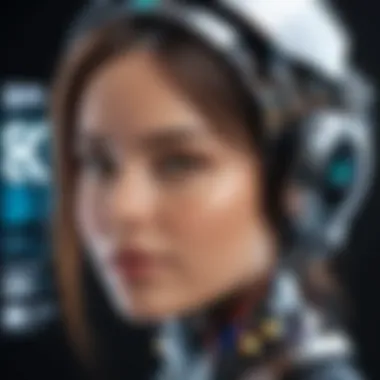Exploring 8K AI Upscaling: A Comprehensive Examination


Intro
The onset of 8K AI upscaling marks a significant evolution in image processing technology. It leverages the capabilities of artificial intelligence to elevate the quality of images, significantly enhancing resolution and clarity. For professionals in the information technology sector, understanding this technology is paramount as its implications extend across various industries including entertainment, gaming, and photography.
In this exploration, we will dissect the fundamental principles of 8K AI upscaling, highlight its applications, and investigate necessary hardware requirements. Also, compatibility challenges and limitations across different platforms will be considered. Ultimately, this article aims to provide IT professionals with a comprehensive understanding of both the current and future landscape of 8K AI upscaling.
Prelude to 8K AI Upscaling
The realm of visual technology has made remarkable strides in recent years, with 8K AI upscaling standing out as a pivotal development. This process enhances image resolution using sophisticated artificial intelligence algorithms. Knowing its significance is essential for anyone involved in information technology and the media industry. This technology reshapes how we perceive digital content, elevating visual clarity to unprecedented levels.
Definition and Functionality
8K AI upscaling refers to the process of converting lower-resolution images into 8K resolution through advanced AI techniques. Unlike traditional upscaling methods, which often produce pixelated or blurred results, AI upscaling leverages machine learning and neural networks. These technologies analyze the original image, learning to predict and create detail that does not exist in the source material. The functionality is predicated on the idea that the AI can extrapolate features and textures from an extensive dataset, thereby enriching the visual output. This process allows content creators to enhance the quality of existing media without needing to reshoot or recollect high-resolution sources.
Historical Context of Image Resolution
Understanding the evolution of image resolution is necessary to appreciate the significance of 8K AI upscaling. Initially, standard definition (SD) dominated the visual landscape. With time, high-definition (HD) and later full HD became the norm. Each progression brought more detail and clarity, leading to increased consumer expectations for visual fidelity.
The transition from HD to 4K represented another major leap; however, the advent of 8K resolution is significantly more transformative. 8K resolves an impressive 7680 x 4320 pixels, offering four times the detail of 4K. AI upscaling came into prominence as the demand for high-resolution content skyrocketed, enabling the enhancement of lower-resolution displays and footage. The journey of image resolution mirrors society's appetite for sharper and more engaging visual experiences.
The development of AI-driven technologies for upscaling marks a crucial turning point in how we can interact with digital media.
The Technology Behind AI Upscaling
The realm of 8K AI upscaling relies heavily on advanced technology designed to enhance the visual quality of images. This technology stands out due to its usage of artificial intelligence, pushing boundaries that traditional methods cannot achieve. Understanding this technology is vital for IT professionals and tech enthusiasts in recognizing both its potential and limitations.
One of the primary advantages of AI upscaling is its ability to analyze images at a granular level. By using sophisticated algorithms, it evaluates each pixel's data independently, resulting in clearer and more detailed final outputs. However, this technology requires adequate hardware capabilities, which can sometimes be a barrier to entry for enthusiasts.
Understanding Neural Networks
Neural networks form the backbone of AI upscaling technology. These networks are designed to mimic the human brain's functioning, utilizing interconnected nodes that work collaboratively. In the context of image processing, neural networks can identify patterns and textures in the source images.
Consequently, when upscaling occurs, these patterns inform the new pixels generated, enhancing image quality. The learning process in neural networks is key. Each iteration improves accuracy, enabling the system to generate images that maintain detail while enlarging the resolution.
Machine Learning Algorithms in Upscaling
Machine learning algorithms are essential to achieving effective upscaling results. Different algorithms can be used in this process, including deep learning and convolutional neural networks (CNNs). These types of algorithms excel in recognizing complex patterns in large datasets.
In upscaling, machine learning algorithms learn from various image data, understanding how to recreate details effectively. The combination of these algorithms with neural networks is what makes AI upscaling distinctly superior to conventional methods.
Training Data and Models
To train machine learning models effectively, high-quality data sets are integral. The data used must encompass a wide range of images with distinct features. This variety allows the algorithms to learn effectively and generate more accurate results during upscaling.
Furthermore, training involves feeding images in various resolutions into the model. This approach helps the model understand how to recreate lower-quality images into higher resolutions accurately. The choice of training data significantly influences the output quality of the AI upscaling process.
Applications of 8K AI Upscaling
The implementations of 8K AI upscaling signify a transformative leap in various domains. This technology does not merely enhance image quality; it redefines the expectations of clarity and detail in visual media. Understanding its applications helps to appreciate its significance in creative fields and technology. Each sector adapts this technology for specific advantages, influencing user experience and artistic expression.
8K AI Upscaling in Entertainment
In the entertainment industry, 8K AI upscaling offers unparalleled enhancements to visual content. Streaming platforms like Netflix and Amazon Prime Video are beginning to adopt this technology to deliver richer and more detailed experiences. By upscaling content to 8K resolution, viewers encounter sharper images that seem more lifelike.


Despite existing content not being filmed in 8K, AI upscaling helps bridge this gap. Content previously recorded in lower resolutions can be transformed, allowing for broader catalog offerings. This upscaling capability ensures that viewers can enjoy their favorite shows and movies with enhanced visual fidelity, providing an immersive experience.
Moreover, the real-time processing capabilities of AI can also enhance live broadcasts. Live events such as sports or concerts can be streamed in 8K resolution, granting viewers a front-row experience from the comfort of their homes.
Impact on Gaming Experience
The gaming landscape has seen substantial changes due to 8K AI upscaling technology. Gamers looking for realism and immersion find that enhanced graphics dramatically influence gameplay experience. Games rendered in 8K can reproduce intricate details, providing gamers with lifelike environments.
Integrating AI upscaling not only improves the initial visual output but also maintains high frame rates essential for competitive gaming. Titles like Cyberpunk 2077 and Call of Duty have increasingly integrated upscaling solutions, allowing smoother play while rendering a sophisticated world. The result is a more engaging and visually compelling experience.
Potential drawbacks do exist, especially related to hardware demands for gaming at such high resolutions. Users must invest in robust graphics processing units and additional RAM to alleviate bottlenecks. Nevertheless, the benefits often outweigh these concerns for serious gamers.
Professional Photography and Videography
In professional photography and videography, 8K AI upscaling plays a vital role in the post-production phase. Photographers and videographers are tasked with producing high-quality imagery for various applications, from marketing materials to film production. Upscaling technology enables them to enhance their portfolios, showcasing images in resolutions that meet contemporary standards.
Professional software like Adobe Photoshop and Final Cut Pro is becoming integrated with upscaling algorithms. This allows artists to stretch their existing work while preserving essential details and minimizing loss. It opens avenues for repurposing older content or capturing the attention of clients who require high-resolution outputs in an increasingly competitive landscape.
The demand for high fidelity imagery continues to grow. Real estate listings, product showcases, and even social media marketing thrive on high-quality visuals. Consequently, the application of 8K AI upscaling presents photographers and videographers with a crucial advantage in meeting client expectations.
"The implementation of 8K AI upscaling technology in photography and videography equips professionals with the tools to excel in an evolving market, ensuring they meet the demands of both quality and creativity."
As a summary, the applications of 8K AI upscaling resonate profoundly across multiple domains. In entertainment, it enhances viewer experience. For gaming, it delivers a more immersive environment, and in photography, it fosters artistic exploration. Each of these fields cannot only leverage existing media but also contributes to an evolving standard of visual excellence.
Evaluating Performance Metrics
Evaluating performance metrics is crucial in understanding the effectiveness of 8K AI upscaling technology. This segment focuses on three critical aspects that inform users about the quality and efficiency of the upscaling process. With advancements in image enhancement, evaluating these metrics can help IT professionals and tech enthusiasts appreciate the nuances of AI upscaling. Key considerations include resolution enhancement and image quality, processing speed and efficiency, and how AI upscaling compares to traditional techniques. Each element plays a significant role in determining overall user experience and potential use cases.
Resolution Enhancement and Quality
The quality of the resolution enhancement is a defining feature of 8K AI upscaling. AI upscaling aims to convert lower-resolution images into high-definition formats, promising sharper images and more details. The algorithms analyze pixel data and utilize sophisticated models to predict how additional pixels should appear. The outcome is often clearer images, but the effectiveness varies depending on the algorithms in use and the original source material's quality. A critical point is that enhanced resolution does not necessarily mean perfect accuracy; some artifacts might still emerge, impacting the viewer's experience.
Processing Speed and Efficiency
Processing speed influences the user’s decision to adopt 8K AI upscaling. Image processing times can vary widely based on hardware capabilities and software optimizations. Efficient upscaling is necessary for real-time applications, such as gaming and live streaming. Users expect procedures to remain smooth without noticeable delays. Multiple configurations exist to enhance processing speed—higher-end GPUs, for example, facilitate quicker processing times and improved frame rates. Finding the balance between quality and speed is essential for IT professionals, especially when designing systems that benefit from upscaling technology.
Comparison with Traditional Upscaling Techniques
When comparing AI upscaling to traditional techniques, such as bicubic interpolation, significant differences arise. Traditional methods enhance image resolution by calculating new pixel values from existing ones. However, these methods often fall short in detail preservation and creating smoother gradients. On the contrary, AI upscaling leverages machine learning to analyze large datasets, resulting in more intelligent predictions regarding pixel placement and finer details. This transformation from reactive to proactive technology leads to superior quality images in a variety of applications.
"Understanding performance metrics allows users to make informed decisions about which upscaling technologies best suit their requirements and environments."
Hardware Requirements for 8K AI Upscaling
The significance of hardware requirements in the realm of 8K AI upscaling cannot be underestimated. This technology demands a robust infrastructure to function efficiently and effectively. Without adequate hardware, the promises of enhanced image quality and improved processing capabilities cannot be realized. In this section, we will examine the essential specifications needed to operate software for AI upscaling, optimal configurations for performance, and compatibility considerations with existing systems.
Minimum Specifications for Software
To embark on the journey of 8K AI upscaling, certain minimum specifications must be met. Generally, the essential requirements include:
- Processor: A strong CPU, preferably a multi-core processor, enhances the software's ability to process complex algorithms and handle multiple tasks simultaneously.
- RAM: At least 16 GB of RAM is recommended, although higher capacity can lead to better performance and reduced lag during processing.
- Graphics Card: A dedicated GPU with support for AI-based tasks is crucial. NVIDIA GTX 1060 or AMD equivalent is often seen as the entry point.
- Operating System: Most AI upscaling software is designed for Windows, requiring Windows 10 or newer.
- Disk Space: A solid-state drive (SSD) with adequate storage to handle large files is advised.
Meeting these minimum specifications can lead to a basic experience, but may not unlock the full potential of AI upscaling functionalities.
Optimal Hardware Configurations


Once the minimum requirements are established, organizations seeking to optimize their experience with 8K AI upscaling should consider higher specifications. Key components include:
- Processor: Utilizing a high-end CPU, such as Intel Core i9 or AMD Ryzen 9, significantly enhances processing speed and efficiency.
- RAM: Expanding to 32 GB or more can vastly improve multitasking and reduce memory bottlenecks when managing multiple projects.
- Graphics Card: A powerful GPU, like NVIDIA RTX 3080, enhances real-time rendering and processing capabilities, especially with advanced deep learning techniques.
- Cooling Solutions: As processing power increases, efficient cooling systems become essential to prevent overheating during extensive tasks.
An optimal configuration not only ensures smooth operation but also maximizes the visual fidelity that 8K AI upscaling can provide.
Compatibility with Existing Systems
As new hardware is integrated to facilitate 8K AI upscaling, compatibility with existing systems becomes paramount. First, ensure:
- Software Support: Confirm that the operating system and drivers are up to date with software requirements.
- Peripheral Devices: Connectors and ports, such as HDMI 2.1, are necessary to output 8K video.
- Integrated Systems: Older systems may need additional upgrades, such as new motherboards capable of supporting modern GPUs.
Understanding the compatibility of hardware can lead to informed decisions, avoiding potential pitfalls when implementing this advanced technology.
A well-planned hardware setup is foundational for leveraging the full benefits of 8K AI upscaling. It paves the way for both current functionality and future advancements in technology.
Challenges and Limitations
Understanding 8K AI upscaling involves recognizing the challenges and limitations that accompany its adoption and use. These factors are critical for IT professionals and tech enthusiasts because they affect the overall effectiveness and functionality of the technology. While the promise of enhanced image quality is alluring, the reality often presents hurdles that can impede performance and usability.
Artifacts and Anomalies in Upscaled Images
One of the primary concerns in 8K AI upscaling is the appearance of artifacts and anomalies in the final output. Artifacts are unwanted elements that distort the intended visuals, which can detract from the viewing experience. For instance, banding in color gradients or halo effects around objects in upscaled images can occur.
This is especially problematic in critical applications such as professional photography and videography, where precision is essential. The presence of these artifacts may stem from several factors, including the algorithms used and the inherent limitations of the original image resolution. Poor source material can exacerbate these issues, making it essential to select high-quality images for upscaling processes.
Time Consumption and Resource Intensity
AI upscaling can be resource-intensive. The computational demand for processing operations can lead to long wait times, especially when handling large files or high volumes of data. This time consumption is often proportional to the quality of the output. More advanced algorithms might yield superior results but at the cost of requiring considerable processing power, which can delay projects.
For IT professionals, this raises significant considerations for workflow efficiency. Investment in hardware solutions that can accommodate the needs of AI upscaling becomes a necessity. For example, powerful GPUs tend to mitigate these delays but increase overall operational costs. Understanding the balance between output quality and time management is crucial in integrating AI upscaling within workflows.
Dependency on Source Material Quality
The quality of the original source material is perhaps the most critical element in 8K AI upscaling. If the source image is of low resolution or contains noise and compression artifacts, the outcome will likely be disappointing regardless of the sophistication of the upscaling technique. An upscale can't create detail that doesn't already appear in the original image; it can only approximate and enhance what exists.
This reliance on the integrity of source materials means that professionals in fields like film, gaming, and photography must invest in maintaining high-quality assets. As a result, even with advanced upscaling solutions, the starting quality can significantly limit potential benefits. Evaluating source materials before the upscaling process becomes essential to achieving desired results.
"The quality of the input significantly determines the quality of the output in image processing."
Notable Software Solutions
In the realm of 8K AI upscaling, software solutions are essential. They empower users to take advantage of the intricate technology that AI provides. Several firms have developed advanced software platforms specifically designed for this purpose. Their importance extends beyond just enhancing image quality; they are pivotal in making this technology accessible to both professionals and enthusiasts.
Leading AI Upscaling Software in the Market
The market for AI upscaling software has seen rapid growth. Various options are available, but a few stand out due to their capabilities and user satisfaction. Notable names include Topaz Video Enhance AI, Gigapixel AI, and Adobe Photoshop with its Super Resolution feature. These products utilize deep learning algorithms to enhance image quality significantly.
- Topaz Video Enhance AI: This software is especially known for its ability to upscale video content. It provides users with several presets based on content type, making it user-friendly.
- Gigapixel AI: Primarily focused on still images, this software excels at enlarging photos while preserving detail. It is often favored by photographers and graphic designers.
- Adobe Photoshop: With the integration of AI, Photoshop has kept its edge. The Super Resolution feature employs machine learning to enhance image resolution effectively, complementing traditional editing tools.
Comparison of Features
When examining the landscape of AI upscaling software, feature comparison is crucial. Each software offers unique tools and benefits. For instance, Topaz Video Enhance AI includes batch processing, allowing users to upscale multiple videos simultaneously, saving considerable time.


On the other hand, Gigapixel AI is tailored for detailed edits, providing controls over the amount of enhancement, making it suitable for fine art prints. Adobe Photoshop, while comprehensive, may not specialize solely in upscaling, but its familiar interface integrates seamlessly with other image editing functionalities.
Factors to consider in comparison:
- User interface design
- Processing speed
- Quality of output
- Support for various formats
User Feedback and Reviews
User feedback plays a fundamental role in understanding how effective these software solutions are in practical scenarios. Reviews often highlight specific strengths and weaknesses. For instance, users of Topaz Video Enhance AI frequently praise its processing power, although some mention the learning curve involved.
Meanwhile, Gigapixel AI users appreciate the high-quality results but sometimes find the price point a consideration. Adobe Photoshop users consistently laud the integration of AI features, but some critique that it requires a strong understanding of the software as a whole.
"AI upscaling has changed how we perceive image enhancement. It is not just a trend, but a vital tool for professionals in various fields."
Future Trends in AI Upscaling Technology
The discussion on future trends in AI upscaling technology is essential because it helps contextualize the advancements this field is experiencing. These trends suggest how the technology may shape industries, enhance user experience, and influence hardware development.
Emerging Technologies and innovations
The landscape of AI upscaling constantly evolves, driven by emerging technologies. Techniques such as Generative Adversarial Networks (GANs) are at the forefront. GANs enable the creation of high-resolution images from low-resolution sources more effectively. Improved algorithms, especially in deep learning, are making it easier to generate realistic images.
Alongside this, advancements in computational power are vital. Graphics processing units (GPUs) and dedicated AI chips are becoming more common. These improvements allow for real-time processing of high-definition content. Other technologies, such as quantum computing, could further accelerate these processes, although this is more speculative at the moment.
Potential Market Growth and Adoption Rates
Market growth for AI upscaling is likely to surge in the coming years. Research indicates significant increases in consumer demand for high-resolution content. As more providers offer 8K content in streaming services like Netflix or Amazon Prime, the need for efficient upscaling technology rises.
Moreover, industries like gaming and videography are seeing substantial investments in this area. The integration of AI upscaling can drastically improve the visual quality of existing content, equating them with newer productions. This dual need—both for creating new content and enhancing old—fuels rapid adoption and growth in market opportunities.
"As industry players recognize the potential of AI upscaling, we expect increased collaboration between software and hardware manufacturers, leading to breakthroughs in how content is delivered and experienced."
Integration with Other Technologies
Integrating AI upscaling with other technologies is critical for maximizing its potential. For instance, combining this upscaling technique with Virtual Reality (VR) or Augmented Reality (AR) can offer richer experiences in these mediums. Improved image resolution holds significant implications for immersive environments.
Additionally, enhancements in cloud computing can facilitate higher processing capabilities. This implies that even devices with lower hardware specifications can deliver high-quality images through cloud-based AI upscaling solutions.
The synergy between AI upscaling and technologies like machine learning can also lead to personalized experiences. Tailoring content to user preferences using AI models could make experiences more engaging and relevant.
Overall, recognizing these trends allows IT professionals and tech enthusiasts to prepare for a future where AI upscaling becomes standard across multimedia platforms.
Finale
The conclusion serves as a vital segment of this article. It encapsulates the discussions and insights presented throughout the various sections regarding 8K AI upscaling. By drawing upon the extensive analysis of technology, applications, and potential limitations, this section aims to crystallize understanding for the readers.
Summary of Key Insights
In previous sections, we explored numerous aspects of 8K AI upscaling. The technology relies heavily on advanced neural networks and machine learning algorithms. These enhance image resolution significantly, producing remarkable quality improvements in various domains such as entertainment and professional photography. 8K AI upscaling not only transforms user experiences but also drives innovation in the media industry.
It is crucial to acknowledge the hardware prerequisites for this technology. Optimal configurations are necessary to support high-resolution processing without significant lag. Additionally, the implications of processing speed and efficiency were analyzed, stressing the importance of high-performance systems in achieving desirable outcomes.
Finally, the challenges and limitations of 8K AI upscaling were discussed. These include potential artifacts in upscaled images and a dependency on the quality of source material. Understanding these constraints is essential for information technology professionals and enthusiasts aiming to implement AI upscaling solutions effectively.
Final Thoughts on 8K AI Upscaling
As we look forward, 8K AI upscaling technology is set to play a pivotal role in various sectors, enhancing both aesthetic quality and user engagement. The market appears promising, with technology advancements continuously reshaping possibilities. However, professionals must remain vigilant about the evolving landscape of both hardware and software.
The integration of emerging technologies alongside traditional systems could redefine current standards, leading to unexpected innovations. Keeping abreast of these advancements will be pivotal for anyone involved in tech or media.
In summary, 8K AI upscaling is not just another technological advancement; it's a significant leap that holds the power to redefine how we perceive and interact with visual content in our increasingly digital world. Encouraging ongoing discourse and study will be essential for harnessing its full potential.



